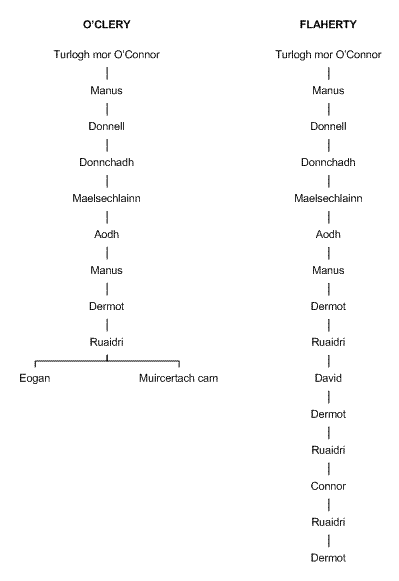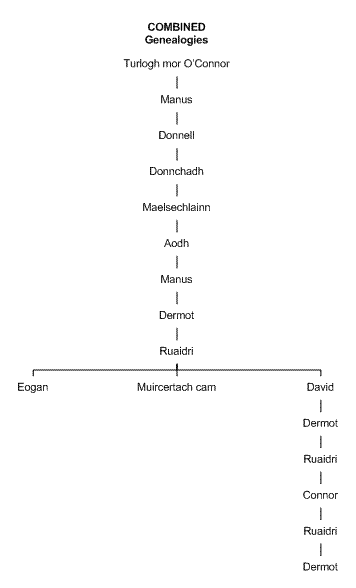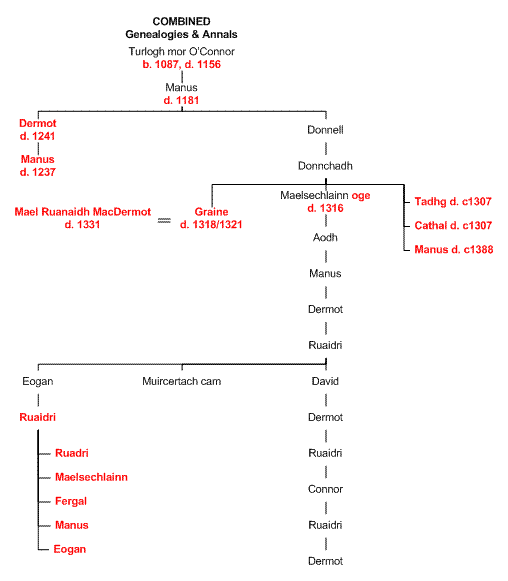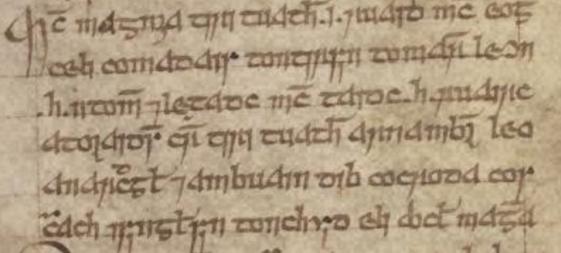
Using The Annals and Pedigrees To Chart Our Past
Phil McManus, Oregon, USA
The primary documentation that forms the framework of our McManus research study comes from two main source types: Irish annals and Irish pedigrees. These can be used to compile reasonably accurate charts of our family lines. What follows is meant as an explanation of the nature and characteristics of the annals and pedigrees and how they may be used to provide some sense of our family lines.
Irish Annals
The Irish annals form a primary record of Ireland's history from the coming of Christianity and Saint Patrick to the English invasions of Ireland. The annals we know today are really a compilation of marginal notes made by priests and monks. These were made on calendars that were kept by the clergy to make certain that feast days, in honor of the various saints, were held properly and in order. Usually these notes were notes and obituaries of other clergy. However some kept more information than that - political events and local happenings of importance to the writer were kept as well. Some of these were to mark a certain calendar so that the event would tie in properly to the calendar and show that the feast days were kept.
A later trend developed among some of the clergy to compile these 'annals' into larger texts to form a history. Often these were literally copied from the marginal notes without embellishment and so preserved the language over time (the scribes could mostly duplicate but not read what they were writing). As this trend developed some earlier books of annals were used to build upon and update.
There are four main annals that we have used as they cover local events and Ireland in general. The information in each can overlap in some instances but they can also individually provide specific items of information which are not mutually inclusive. This is mainly due to their separation in time, their locality and the material available to the compilers.
Annals of Senat aka Annals of Ulster (AU)
This is the compilation written primarily by the great cleric Cathal Óg (MacManus) Maguire, assisted by scribes Rory O'Luneen and others. Cathal mainly details the history of the diocese of Clogher from both a secular and religious perspective. As the annals progress from the early times towards the time of Cathal he added more and more details of his own family as well as the nobles and notables in the region. These annals cover the time from Saint Patrick to the death of Cathal, at which time Cathal's son undertook their completion up to about 1510.
Annals of Loch Cé (ALC)
This manuscript was written/transcribed in 1588 by Philip Badley O'Duignan, Dubthach O'Duignan, Conaire O'Duignan, and others on behalf of their patron Brian MacDermot, lord of Moylurg. The historical region of Moylurg, in County Roscommon, is generally associated with the contemporary town of Boyle at its centre. In the eastern part of the region is the ancient border territory of Tir Tuathail - the territory of the McManuses of Kilronan. Brian MacDermot resided on Carrick MacDermot, a crannog on Loch Cé, near Boyle. Even Brian was involved in the writing of these annals as it has been noted that some of the entries are in his handwriting. These annals cover the period 1014 to 1571 with a gap from 1138 to 1170. The authors, O'Duignans, were hereditary priests of the church of Kilronan and so had first-hand knowledge of the events in that region.
Annals of Kingdom of Ireland (AFM)
These annals are a compilation of the earlier annals, including those above, in a timeframe where the Irish clergy and nobility were gravely persecuted between 1631 to 1632. The document is noted as having been transcribed by five different men, two of whom were Michael O'Clery and Cucory O'Clery.
Annals of Connacht (AC)
The Annals of Connacht, cover the years 1224 to 1544 and are drawn from a manuscript compiled in the 15th and 16th centuries by at least three scribes, all believed to be members of the Ó Duibhgeannáin family. The early sections commence with the death of King Cathal O'Conor of Connacht and give a good account of the affairs of Connacht during the 13th and early to mid 14th century, particularly for the families of O'Conor and Burke.
Irish Pedigrees
Irish pedigrees abound from a few short fragments to large volumes and range from factual and authoritative to extreme wishful thinking and fancy. It can be said that anything before 300 A.D. should be taken with a pinch of salt. Before the coming of Saint Patrick and Christianity to Ireland the history and pedigrees were merely oral in nature. With the introduction of Latin came writing and trained clerics began recording a written history for the Irish. The earliest of these genealogical transcriptions were written around the years between 1100 to 1200 A.D. and cover the framework for the later genealogies. They show the then existing clan groups as a larger group and not much detail is given. Later genealogies would be expanded for certain portions of the population, especially noble families or larger groups in the region.
It is agreed that some pedigrees are merely devices for the benefit of persons to show a prestigious connection to nobility and other notable individuals from the past. Unfortunately they have sometimes been falsified yet have found their way into more authoritative writings. In some cases this has caused considerable conflict and uncertainty. The arrangement of the material can also confuse the reader in some instances. In general, however, these problems do not necessarily negate the pedigrees and they often contain some truth. The easiest way to determine the truth is to compare the genealogies side-by-side and then overlay the bits and pieces of annals. Prior to about 1100 the annals often refer to individuals by first name as surnames had not come into use until after this date.
The core group of genealogical documents that we use in our study
are as follows:
Using two of the base pedigrees from O'Clery's and Flaherty's entries for McManus O'Conor, of Tir-Tuathail, and comparing their information by chart, we can determine a reasonably accurate framework of the line:

We can see that both agree for the first nine generations. Then one seems to stop at two sons while the other continues with another line. This may not be a discrepancy but rather one stopped at a family current at the time while the other continued to a later point in time through a third son of Ruaidri. If we combine them we get a more accurate lineage as follows:

If we add in another pedigree from the book of the O'Connor Don, which was written between 1432 -1441, plus information from the Annals of the Four Masters, we can see the forming of a more complete pedigree.

There are more entries to expand on this but we do have here the basic documentation of the McManus O'Connor family of Tir-Tuathail (Kilronan).

Annals of Loch Cé - 1460, paragraph 8
Using this methodology we have created a truncated pedigree of the two McManus families (O'Connor and Maguire) and their related cousin-families. With this we can springboard to selecting results of those cousin-families to see the degree of matching and hopefully proving the pedigrees and origins.
Following are charts resulting from our studies. In both we trace family lines along surname divisions within a larger Irish tribe. When a representative from a particular branch is found and tested, the figure that represents that line is reflected by making them a solid figure versus an unrepresented line as outline. Each figure is a nexus person where it is known within the documentation to represent a distinct line or branch of the family.
[Click each image for a larger view in a new window, where you can zoom and scroll as necessary.]